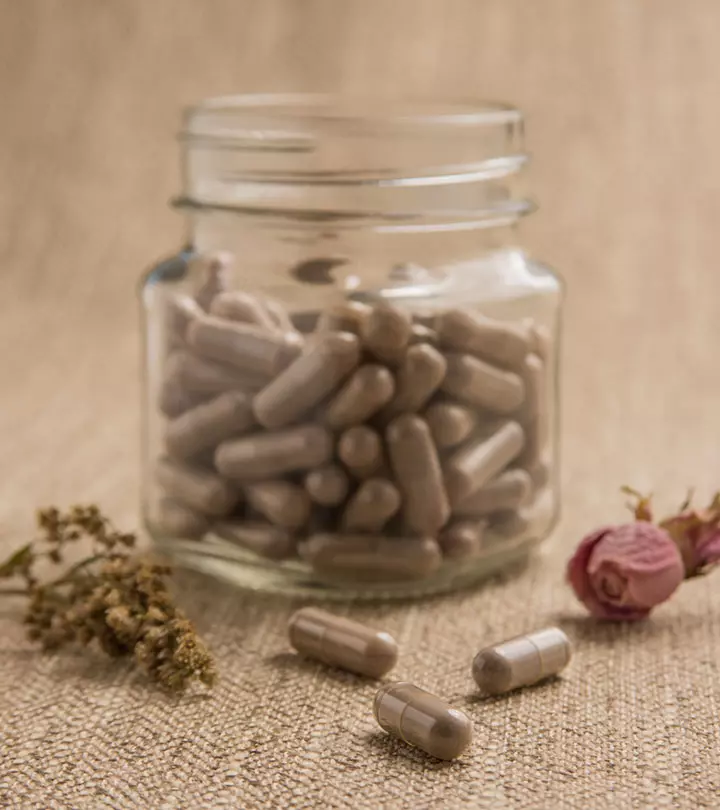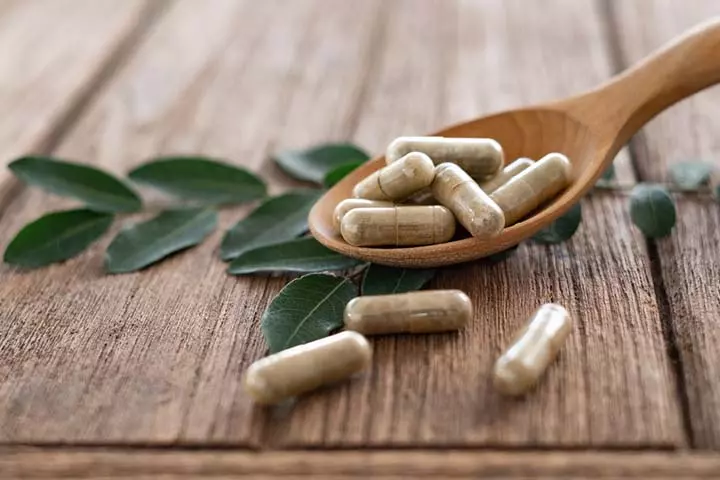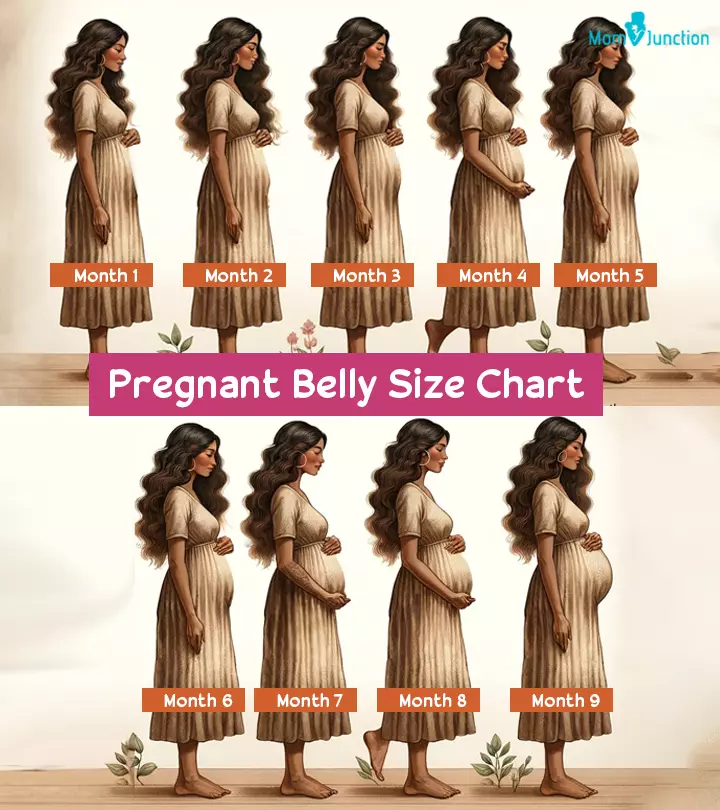
Image: Shutterstock
Placenta encapsulationiThe process of filling and enclosing capsules for human consumption involves the conversion of the human placenta into dried powder and processed pills, which women ingest postpartum. Several mammals eat their placenta after giving birth, but the tradition is not culturally widespread in humans (1). Although some women believe it might provide several benefits to help them rebound after childbirth, some experts think it may harm the mother and the baby.

Read on to learn about placenta encapsulation, its types, benefits, adverse effects, and more.
Key Pointers
- Some women consume placenta capsules after childbirth for supposed health benefits.
- There is no scientific evidence to confirm the claimed benefits of ingesting placenta.
- Consuming the placenta may also have negative effects on a woman and her baby’s health.
- It is best to consult your healthcare team for safe and proven alternatives.
Is Placenta Encapsulation Safe?

The human placenta is known to be a good source of essential micronutrients such as iron and zinc. These nutrients are crucial for promoting wellness, aiding in the healing process, and supporting overall recovery for postpartum women; however, it also contains minimal amounts of toxic elements (2). Therefore, following the process of placenta encapsulation without proper medical advice is not advisable. Consequently, the Centers for Disease Control and Prevention (CDC) recommends that women avoid consuming placenta or its capsules to prevent the potential risks of acquiring and transmitting infections (3).
Furthermore, when the encapsulation procedure is done under non-stringent conditions or when the pills are consumed without considering other maternal health factors, they may do more harm than good.
 Did you know?
Did you know?What Are The Encapsulation Methods?
The placenta encapsulation process could be of the following two types (5).
- Dried capsules
The placenta is extracted, cleaned thoroughly, sliced thin, cooked, dried (or dehydrated), and ground into fine powder. The powder is then put into capsules and taken as pills.
- Traditional Chinese medicine
The placenta is used as a natural traditional medicine in Chinese culture. It is steamed, sliced, dried (or dehydrated), and encapsulated in medicinal form. However, a Chinese pill may also contain additional elements or herbs and may be used by people other than postpartum mothers.

Note: Some women may also consume placental tissues in other forms, such as blending them into smoothies or as an added ingredient to a meal.
An anonymous blogger shares the techniques she employed to prepare her placenta for consumption. She says, “I cut it up and sauteed in butter. It cooked up just like other organ meat. After I cooked it, I put it in a container and later added it to some regular ground beef. I added taco seasoning, mixed it all up, and made myself some Placenta Tacos. The placenta tasted a bit chewy, but other than that, it tasted just like tacos and was yummy. Later, I encapsulated the other half (i).”
Refrain from consuming raw tissues, which may cause undesirable health consequences (6).
How Is Placenta Encapsulation Done?
The process of placenta encapsulation must be performed in a duly sterile environment by specialists, and it generally involves the following steps (7).
- Recovering the placenta within a few hours of delivery.
- Cleaning (rinsing under water) of the placenta until the blood and clots are removed.
- Chopping the placenta into thin slices.
- Drying the pieces in a dehydrator (for 8 hours) at 54°C.
- Grinding the slices into a fine powder using a food processor.
- Filling the powder in edible capsules.
 Quick fact
Quick factWhat Are The Perceived Benefits Of Eating Placenta?

Placenta encapsulation is thought to provide nourishment to new mothers and help them cope with the physical and emotional demands of childbirth. It may also contain beneficial nutrients and hormones. Although there is a shortage of credible research backing the benefits of placenta encapsulation, it is believed to confer the following holistic health advantages to mothers post-childbirth (8) (9).
- Boosting energy
- Controlling postpartum bleeding
- Reducing mood swings
- Enhancing mother-infant emotional bonding
- Promoting milk production
- Alleviating pain
- Preventing stress and postpartum depression
 Expert says
Expert saysWhat Are The Potential Risks Of Eating Placenta?
Placenta is a body tissue prone to contamination and decomposition once separated from the body. Hence, consuming raw or dried placenta is a potential source of infection for the mother. Below are the various risks of eating placenta (6) (7) (10):
- Higher risk of maternal infections
- Risk of transmitting infections to the infant (such as group-B strep infectioniA bacterial infection that may cause severe illness, especially in newborns )
- Risk of exposure to toxic metals such as lead and mercury and drugs (from the childbirth process)
- Increased risk of experiencing blood clots
- Adverse effects on breast milk production (particularly when mothers have blocked ducts or mastitis)

Should You Try Placenta Encapsulation?
Several women ponder that the placenta can continue to provide health advantages even after childbirth, similar to how it aided their child during pregnancy.
However, this should not be your motive to eat placenta or its capsules postpartum. Moreover, placenta encapsulation is not an FDA-approved process. Improperly processed supplements made from placenta may have adverse effects on one’s well-being, and therefore, pose significant risks (11). Therefore, you must approach the process with caution and seek support from your healthcare provider or midwife to understand its efficacy and potential consequences.

Frequently Asked Questions
1. Is placenta encapsulation the same thing as eating the placenta?
Encapsulation is the process of filling a substance into a capsule. Most women consume the placenta in the encapsulated capsule form (12). However, some women may also consume dehydrated placenta without encapsulation.
2. What is the taste of the placenta?
The taste of the placenta is not well-documented, but a few studies revealed that women who consumed placenta reported an unsavory taste and unpleasant smell (13).
3. Is consuming the placenta cannibalism?
Although the maternal placenta legally belongs to the mother (7), a study suggests that a few people may ethically categorize placentophagyiIngestion of the placenta after giving birth in mammals as a possible form of cannibalismiA phenomenon of humans consuming their flesh or internal organs ; however, no deemed authority has proven this conjecture (14).
Although most women who tried them may claim the supposed benefits of placenta-encapsulated supplements, there are no definitive scientific studies to prove the alleged benefits of it on a large scale. Moreover, many experts recommend avoiding placenta capsules during lactation due to potential risks to the baby. If you still wish to have encapsulated placenta, make sure you plan for it during your pregnancy after consulting in detail about it with your healthcare provider.
Infographic: Theorized Benefits And Probable Risks Of Consuming Placenta
Some women may consider consuming placenta under the notion that it might help them recover and improve their overall health after childbirth. However, the validity of such claims remains inconclusive due to a lack of robust scientific evidence. Therefore, if you are interested in ingesting placenta capsules, give this infographic a read as it outlines the presumed benefits and adverse effects of the practice.
Some thing wrong with infographic shortcode. please verify shortcode syntax
Illustration: Placenta Encapsulation: Safety Benefits And Risks

Image: Stable Diffusion/MomJunction Design Team
Delve into the benefits and drawbacks of placenta encapsulation for mothers in this informative video. Gain insights and make an informed decision.
Personal Experience: Source
MomJunction articles include first-hand experiences to provide you with better insights through real-life narratives. Here are the sources of personal accounts referenced in this article.
i. Yes, I ate my placenta;https://mabtest1.blogspot.com/2011/08/yes-i-ate-my-placenta.html
References
- Alex Farr et al. (2018); Human placentophagy: a review.
https://www.ajog.org/article/S0002-9378(17)30963-8/fulltext#%20 - Sharon M.Young et al. (2016); Human placenta processed for encapsulation contains modest concentrations of 14 trace minerals and elements.
https://www.sciencedirect.com/science/article/abs/pii/S0271531716300227 - Genevieve L. Buser et al. (2016); Notes from the Field: Late-Onset Infant Group B Streptococcus Infection Associated with Maternal Consumption of Capsules Containing Dehydrated Placenta — Oregon 2016.
https://www.cdc.gov/mmwr/volumes/66/wr/mm6625a4.htm - Sophia K. Johnson et al. (2018); Placenta – Worth Trying? Human Maternal Placentophagy: Possible Benefit and Potential Risks.
https://www.ncbi.nlm.nih.gov/pmc/articles/PMC6138470/ - Mark B.Kristal et al. (2025); Placentophagia and the Tao of POEF.
https://www.sciencedirect.com/science/article/pii/S014976342200481X#bib128 - Placenta Pills: Do They Really Help?; Cleaveland Clinic
https://health.clevelandclinic.org/placenta-pills-why-some-new-moms-take-them-and-what-doctors-say-about-the-risks - Sophia K. Johnson et al. (2018); Placenta – Worth Trying? Human Maternal Placentophagy: Possible Benefit and Potential Risks.
https://www.ncbi.nlm.nih.gov/pmc/articles/PMC6138470/#!po=53.5714 - Cynthia W. Coyle et al. (2015); Placentophagy: Therapeutic Miracle or Myth?
https://www.ncbi.nlm.nih.gov/pmc/articles/PMC4580132/ - Placenta Encapsulation- What Should You Know?
https://goldengateobgyn.org/placenta-encapsulation/ - Daniel Mota-Rojas et al. (2025); Consumption of Maternal Placenta in Humans and Nonhuman Mammals: Beneficial and Adverse Effects.
https://www.ncbi.nlm.nih.gov/pmc/articles/PMC7765311/#!po=30.0000 - Why I can’t recommend eating your placenta.
https://utswmed.org/medblog/eating-placenta/ - Daniel C. Benyshek et al. (2018); Placentophagy among women planning community births in the United States: Frequency rationale and associated neonatal outcomes.
https://onlinelibrary.wiley.com/doi/10.1111/birt.12354 - Emily HartHayes; (2016); Consumption of the Placenta in the Postpartum Period.
https://www.sciencedirect.com/science/article/abs/pii/S088421751500009X - Riley Botelle and Chris Willott; (2025); Birth attitudes and placentophagy: a thematic discourse analysis of discussions on UK parenting forums.
https://www.ncbi.nlm.nih.gov/pmc/articles/PMC7059278/
Community Experiences
Join the conversation and become a part of our nurturing community! Share your stories, experiences, and insights to connect with fellow parents.
Read full bio of Dr. Swati Chitnis
Read full bio of Vidya Tadapatri
Read full bio of Rebecca Malachi
Read full bio of Dr. Joyani Das

















